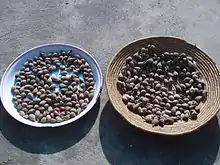| Aframomum corrorima | |
|---|---|
 | |
| Dried korarima fruits, in preparation for making berbere | |
| Scientific classification | |
| Kingdom: | Plantae |
| Clade: | Tracheophytes |
| Clade: | Angiosperms |
| Clade: | Monocots |
| Clade: | Commelinids |
| Order: | Zingiberales |
| Family: | Zingiberaceae |
| Genus: | Aframomum |
| Species: | A. corrorima |
| Binomial name | |
| Aframomum corrorima | |
| Synonyms[2][3] | |
| |
Aframomum corrorima is a species of flowering plant in the ginger family, Zingiberaceae.[4] It's a herbaceous perennial that produces leafy stems 1–2 meters tall from rhizomatous roots.[5] The alternately-arranged leaves are dark green, 10–30 cm long and 2.5–6 cm across, elliptical to oblong in shape.[6] Pink flowers are borne near the ground and give way to red, fleshy fruits containing shiny brown seeds, which are typically 3–5 mm in diameter.[7]
The spice, known as Ethiopian cardamom, false cardamom, or korarima,[2] is obtained from the plant's seeds (usually dried), and is extensively used in Ethiopian and Eritrean cuisine. It is an ingredient in berbere, mitmita, awaze, and other spice mixtures, and is also used to flavor coffee.[8] Its flavor is comparable to that of the closely related Elettaria cardamomum or green cardamom.[9] In Ethiopian herbal medicine, the seeds are used as a tonic, carminative, and laxative.[10]
The plant is native to Tanzania, western Ethiopia[2] (in the vicinity of Lake Tana and Gelemso), southwestern Sudan, western Uganda.[2] It is cultivated in both Ethiopia and Eritrea,[2] although the fruits are typically harvested from wild plants.[11] The dried fruits are widely sold in markets and are relatively expensive, while fresh fruits are sold in production areas.[11]
In dried seeds and pods, the major oil components are 1,8-cineole (eucalyptol) and (E)-nerolidol.[12] In fresh seeds, the major component of the essential oil is 1,8-cineole, followed by sabinene and geraniol.[11] In fresh pods, the major oil constituents are γ-terpinene, β-pinene, α-phellandrene, 1,8-cineole, and p-cymene.[11]
 Kororima fruits are placed in a vessel for grinding.
Kororima fruits are placed in a vessel for grinding. Kororima pods have been ground so that the seeds may be removed.
Kororima pods have been ground so that the seeds may be removed.
See also
References
- ↑ Harris, D.J.; Wortley, A.H.; Olander, S.B. (2019). "Aframomum corrorima". IUCN Red List of Threatened Species. 2019: e.T117206565A124285245. doi:10.2305/IUCN.UK.2019-3.RLTS.T117206565A124285245.en. Retrieved 19 November 2021.
- 1 2 3 4 5 6 Aframomum corrorima was published in "Spices, Condiments and Medicinal Plants in Ethiopia: Their Taxonomy and Agricultural Significance", Agricultural Research Report no. 906, and Belmontia New Series vol. 12 p. 10; 1981. The specific epithet was taken from its basionym, Amomum corrorima A.Braun. Germplasm Resources Information Network (GRIN) (April 9, 2011). "Aframomum corrorima information from NPGS/GRIN". Taxonomy for Plants. National Germplasm Resources Laboratory (NGRL), Beltsville, Maryland: United States Department of Agriculture (USDA), Agricultural Research Service (ARS), and National Genetic Resources Program (NGRP). Archived from the original on 11 October 2012. Retrieved June 19, 2011.
Synonyms: (≡) Amomum corrorima A.Braun (basionym)
- ↑ Amomum corrorima A.Braun, the basionym of Aframomum corrorima (A.Braun) P.C.M.Jansen, was originally described and published in Flora vol. 31, p. 95; 1848. GRIN. "Amomum corrorima information from NPGS/GRIN". Taxonomy for Plants. NGRL, Beltsville, Maryland: USDA / ARS / NGRP. Archived from the original on 11 October 2012. Retrieved June 19, 2011.
- ↑ "Aframomum corrorima (A.Braun) P.C.M.Jansen". Plants of the World Online. The Trustees of the Royal Botanic Gardens, Kew. n.d. Retrieved September 25, 2020.
- ↑ "Aframomum corrorima - Useful Tropical Plants". tropical.theferns.info. Retrieved 2021-04-12.
- ↑ "Korarima". elmaskincare.com. Retrieved 2021-04-12.
- ↑ Van Wyk, Ben-Erik (2013). Culinary Herbs and Spices of the World. The University of Chicago Press. p. 28. ISBN 978-0-226-09166-2.
- ↑ Roussel, Bernard; Verdeaux, François (April 6–10, 2003). "Natural patrimony and local communities in ethiopia: Geographical advantages and limitations of a system of indications" (PDF). 29th Annual Spring Symposium of Centre for African Studies. Archived from the original (PDF) on 2006-11-26.
This Zingiberaceae, Aframomum corrorima (Braun) Jansen, is gathered in forests, and also grown in gardens. It is a basic spice in Ethiopia, used to flavor coffee and as an ingredient in various widely used condiments (berbere, mitmita, awaze, among others).
- ↑ Wondyifraw Tefera (April 2004). "Introduction" (PDF). In Vitro Propagation and Polyploid Induction of Korarima (Aframomum corrorima (Braun) Jansen) and Krawan (Amomum krervanh Pierre) (PhD thesis). Kasetsart University. p. 1. ISBN 974-273-356-2. Archived from the original (PDF) on 2020-08-03. Retrieved 3 August 2020 – via Ethiopian Institute of Agricultural Research.
- ↑ Jansen, P. C. M. (2002). Oyen, L. P. A.; Lemmens, R. H. M. J. (eds.). "Aframomum corrorima (Braun)". Protabase. Wageningen, Netherlands: Plant Resources of Tropical Africa (PROTA) / Ressources végétales de l’Afrique tropicale. Archived from the original on 2008-11-20.
- 1 2 3 4 Eyob, S.; Appelgren, M.; Rohloff, J.; Tsegaye, A.; Messele, G. (2007). "Chemical composition of essential oils from fresh plant parts of korarima (aframomum corrorima) cultivated in the highland of southern ethiopia". Journal of Essential Oil Research. 19 (4): 372–375. doi:10.1080/10412905.2007.9699308. S2CID 85033149. Retrieved 5 August 2020.
- ↑ Hymete, A.; Rohloff, J.; Iversen, T.‐H. (2006). "Essential oil from seeds and husks of Aframomum corrorima from Ethiopia". Flavour and Fragrance Journal. 21 (4): 642–644. doi:10.1002/ffj.1634. Cited in Eyob et al (2007), p. 373.
External links
